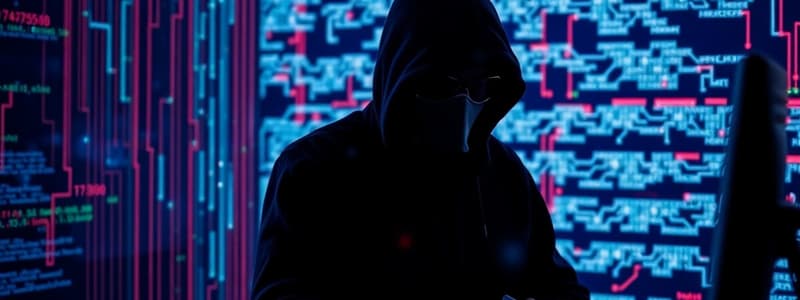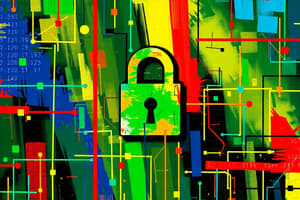Podcast
Questions and Answers
What is the primary purpose of an index within a lesson or topic?
What is the primary purpose of an index within a lesson or topic?
- To provide a comprehensive overview of the entire lesson.
- To offer a summary of the key points in the lesson.
- To list all the examples used in the lesson.
- To assist in quickly locating specific information. (correct)
Besides terminology, what else does an index help in locating?
Besides terminology, what else does an index help in locating?
- Key concepts within the lesson or topic. (correct)
- References to external sources and research.
- The author's credentials and background.
- The lesson's evaluation and review materials.
What type of items would most likely not be found using an index?
What type of items would most likely not be found using an index?
- Particular tasks mentioned.
- Definitions of concepts used
- General background information not specific to the lesson. (correct)
- Specific technologies discussed.
An index is primarily a tool for:
An index is primarily a tool for:
Which factor does NOT directly contribute to data vulnerability?
Which factor does NOT directly contribute to data vulnerability?
How does an index contribute to a learner's experience with instructional materials?
How does an index contribute to a learner's experience with instructional materials?
What is the primary requirement for systems that handle data with respect to security?
What is the primary requirement for systems that handle data with respect to security?
Which of the following actions is LEAST relevant to securing data?
Which of the following actions is LEAST relevant to securing data?
If data is vulnerable in its lifecycle, what should systems that manage data do?
If data is vulnerable in its lifecycle, what should systems that manage data do?
What aspect of data handling, if compromised, would NOT be considered a vulnerability?
What aspect of data handling, if compromised, would NOT be considered a vulnerability?
Why is it beneficial for an organization to use security frameworks?
Why is it beneficial for an organization to use security frameworks?
What is a primary risk of not using security frameworks when developing a security program?
What is a primary risk of not using security frameworks when developing a security program?
An organization decides to build a security program without external guidance. What is a likely consequence of this decision?
An organization decides to build a security program without external guidance. What is a likely consequence of this decision?
What fundamental purpose do security frameworks serve in protecting organizations?
What fundamental purpose do security frameworks serve in protecting organizations?
Why is it considered detrimental to build a security program 'in a vacuum'?
Why is it considered detrimental to build a security program 'in a vacuum'?
What is the primary concern that all organizations, regardless of sector, should share?
What is the primary concern that all organizations, regardless of sector, should share?
Which entities, in both the profit and non-profit sectors, should prioritize security?
Which entities, in both the profit and non-profit sectors, should prioritize security?
What specific aspects of an organization should be protected according to the text?
What specific aspects of an organization should be protected according to the text?
What does the text infer regarding the importance of security across different business models?
What does the text infer regarding the importance of security across different business models?
What is the potential issue that organizations should safeguard their resources against?
What is the potential issue that organizations should safeguard their resources against?
What is a crucial requirement for a sophisticated threat actor group?
What is a crucial requirement for a sophisticated threat actor group?
Which type of professional skill is most likely needed by a sophisticated threat actor group?
Which type of professional skill is most likely needed by a sophisticated threat actor group?
What type of resource is necessary for sophisticated threat actors in addition to technical skills?
What type of resource is necessary for sophisticated threat actors in addition to technical skills?
What is indicated by the need for 'customized attack tools' within a sophisticated threat actor group?
What is indicated by the need for 'customized attack tools' within a sophisticated threat actor group?
Besides coders, what personnel are vital for a sophisticated threat actor group's operations?
Besides coders, what personnel are vital for a sophisticated threat actor group's operations?
Which type of attack primarily aims to compromise the confidentiality of data?
Which type of attack primarily aims to compromise the confidentiality of data?
A disinformation attack most directly undermines which aspect of the CIA triad?
A disinformation attack most directly undermines which aspect of the CIA triad?
If a system suffers a service disruption, which principle of the CIA triad is primarily affected?
If a system suffers a service disruption, which principle of the CIA triad is primarily affected?
Which scenario best represents a compromise of data integrity?
Which scenario best represents a compromise of data integrity?
An attacker successfully copies sensitive files from a database. This action is best described as a compromise of:
An attacker successfully copies sensitive files from a database. This action is best described as a compromise of:
Flashcards
Index
Index
A list of words, phrases, or concepts that helps you find specific information in a document.
Terminology
Terminology
Specific words or phrases used in a subject or field.
Concepts
Concepts
Ideas or theories that explain how something works.
Technologies
Technologies
Signup and view all the flashcards
Tasks
Tasks
Signup and view all the flashcards
Data storage
Data storage
Signup and view all the flashcards
Data transfer
Data transfer
Signup and view all the flashcards
Data processing
Data processing
Signup and view all the flashcards
Data security
Data security
Signup and view all the flashcards
Security properties
Security properties
Signup and view all the flashcards
Security Framework
Security Framework
Signup and view all the flashcards
Systematic Security Approach
Systematic Security Approach
Signup and view all the flashcards
Established Security Principles
Established Security Principles
Signup and view all the flashcards
Building in a Vacuum
Building in a Vacuum
Signup and view all the flashcards
Weak Foundation
Weak Foundation
Signup and view all the flashcards
Security for Organizations
Security for Organizations
Signup and view all the flashcards
Organization
Organization
Signup and view all the flashcards
Equipment Security
Equipment Security
Signup and view all the flashcards
Employee Security
Employee Security
Signup and view all the flashcards
Threat Actors
Threat Actors
Signup and view all the flashcards
Customized Attack Tools
Customized Attack Tools
Signup and view all the flashcards
Skilled Strategists, Designers, Coders, Hackers, and Social Engineers
Skilled Strategists, Designers, Coders, Hackers, and Social Engineers
Signup and view all the flashcards
Resource Acquisition
Resource Acquisition
Signup and view all the flashcards
Resourcefulness
Resourcefulness
Signup and view all the flashcards
Data Exfiltration
Data Exfiltration
Signup and view all the flashcards
Disinformation attack
Disinformation attack
Signup and view all the flashcards
Service Disruption
Service Disruption
Signup and view all the flashcards
Confidentiality
Confidentiality
Signup and view all the flashcards
Integrity
Integrity
Signup and view all the flashcards
Study Notes
Data Security
- Data vulnerability stems from storage, transfer, and processing methods.
- Security properties are essential for data systems (storage, transmission, and processing).
- Security frameworks prevent ad-hoc security programs and ensure a solid foundation.
- Organizations in all sectors (profit/non-profit) need secure data, equipment, and personnel.
Threat Actors
- Sophisticated threat actors require resources (tools, skilled personnel).
- Threat actors leverage strategies affecting the CIA triad (Confidentiality, Integrity, Availability).
- Exfiltration compromises confidentiality.
- Disinformation attacks harm integrity.
- Service disruption targets availability.
Studying That Suits You
Use AI to generate personalized quizzes and flashcards to suit your learning preferences.




